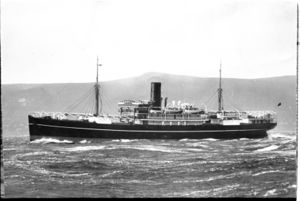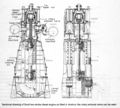Anshun I
Sister of the ship Anhui II with Diesel engine.
| Anshun I | |
|---|---|
| ID /IMO No. 5508284. | |

| |
| Type | Cargo/passenger. |
| Sister of the Anhui II | |
| Gross Registered Tonnage | 3,188 grt. 1.869 nett. |
| Builder | Scotts' S & E Co. Ltd., Greenock. Yard No. 552. |
| Delivery date | 1930 |
| Hull | Steel, clincher construction. |
| Decks | 3. |
| Length | 336.0 ft. |
| Width | 50.0 ft. |
| Depth | 25.5 ft. |
| Passengers | 1st Class 32, 2nd.Class 16, plus deck passengers. |
| Engine Builder | Scotts S.& E.Co. |
| Engine Type | Scott diesel, 2 stroke single acting, direct reversing, solid injection.] |
| Engine cylinders | 6, 27 ins.dia. |
| Engine stroke | 3.75 ft. |
| Engine Power | 3,000 bhp. |
| Engine RPM | 112 |
| Propulsion mode | Single Screw |
| Speed | 12 knots |
| Rigged | Schooner. |
| Displacement | 6,434 tons. |
| Deadweight | 3,658 tons. |
| Bale capacity | 253,200 cu.ft. |
| Block coefficient (Cb) | 0.657. |
| Power | Diesel |
| Aspiration | Natural. |
| Fuel | Diesel oil. |
| Generator | 3, diesel. |
| Generator power | Each, 85 Kw. |
| Generator voltage | 220V DC. |
| Propeller | Right hand, 15.0 ft.dia. 13.75 ft. pitch. |
| Propeller blades | 4. |
| Propeller formation | Solid. |
| Propeller material | Bronze |
| Built classification society | B.O.T. |
| Keel laid | Nov 28th. 1929. |
| Launched | Oct 27th. 1930. |
| Launched by | Mrs. J. Swire. |
| Original owner | China Navigation Co. |
| Notes | |
| 1 emergency generator, 12Kw. | |
Contents
History
The following description and the drawings in the Images section is reproduced from the Transactions of the Instutute of Marine Engineers, Volume 106, Part 2, of 1994.
This Scott Diesel engine, was the only one of this model, which was designed and built by Scotts Engineering and Dockyard. The cylinder design was similar to that of the Still engine but with a longer stroke. A rotary exhaust valve was used to control the exhaust timing, which enabled a shorter piston skirt, enabling a reduction in engine height. A pair of double acting scavenge pumps, rotating at 1.5 times the engine speed, were positioned between the two groups of three cylinders. Piston and cylinder construction followed that of the "Still" engine, oil cooled pistons being profiled to obtain optimum scavenging of the cylinder. Each cylinder had its own solid fuel injection pumps, these being arranged in groups of three at the back of the engine. A separate forced lubrication system applied to fuel pump cam boxes in order to avoid fuel contamination of the main lubrication system. A timed cylinder lubrication was provided. View the Images section for drawings of the engine.
The Yochow II and Yunnan III were each equipped with a similar 5 cylinder main engine with a slightly smaller bore. In this version the scavenge air pumps being located at the for'd end of the engine, and the scavenge air trunking being located below the cylinders.
Aug.1939. Requisitioned by the Royal Navy, and became a stores issuing ship at Freetown, Sierra Leone. Here weed growth on the ship's hull became a problem.
June 1940. Reverted to C.N.Co. as managers for the Shipping Controller.
November 10th. 1941. Vessel went on fire, no blame attached. The Master, Colin Percival Miller complimented on his action in extinguishing the fire.
Dec 10th. 1941. At Manila, damaged by bombs and incendiaries from Japanese aircraft. The 1st Mate James William Bennett, and two seamen were killed by a direct hit. However the "Anshun I" managed to reach Java.
December 21st. 1941. The Anshun I suffered an engine breakdown en route to Fremantle, and was towed the 1,127 nautical miles by the Hanyang II arriving at Freemantle early January 1942.
March 1942. Commissioned by the R.A.N. as H.M.A.S, "Anshun I", Pennant Y1 and employed as a stores issuing ship. In June 1942, she was transferred to the U.S. Army, similar duties.
During the night of Sept.6th. 1942. the Anshun I was sunk by the Japanese cruiser "Tenryu" which fired 14 shells from about two miles away which hit the "Anshun I" on the starboard side while the "Anshun I" was still alongside the wharf (jetty) at the Port of Gili Gili, Milne Bay, T.P.N.G. The "Anshun I" sustained direct hits on the rear gun platform, the bridge and the holds and being riddled with shrapnel and splinter holes. The "Anshun I" eventually heeled over and sank on its side on the sea bed at a depth of 35 ft., approximately 80 ft. from the wharf. Fortunately this happened about one and a half hours after all the troops had disembarked. On September 7th. the "Arunta" entered Milne Bay and picked up the survivors from the "Anshun I" and took them to Townsville.
Until the "Anshun I" was raised other vessels were able to berth along side the wharf between the wreck and wharf, there being a sufficient gap.
In the photographs below of the Anshun I on the sea bed at Gili Gili, the other vessel between the Anshun I is probably the Poyang II
1944. Ship raised, towed to Sydney and laid up.
Nov. 1946. Bought by Jas. Patrick & Co. Pty. Ltd. who refitted her in Melbourne.
Aug 1948. Entered service for Jas. Patrick & Co. as "Culcairn"
May 1962, Sold to Pan Norse S.S.Co. of Panama. Wallem & Co.as managers. name still "Culcairn"
1964. Renamed "Lombok" by the Mercantile Shipping Developmeny Co., same managers. Employed as a livestock carrier on charter to Indonesia.
Jan 10th. 1966. Seriously damaged by fire at Sourabaya.
May 9th. 1966. Arrived under tow in Hong Kong.
July 1966. Sold to Ming Hing Ltd. for breaking up.
Service
Built for the Hong Kong - Swatow - Manila - Singapore - and South East Asia service.







